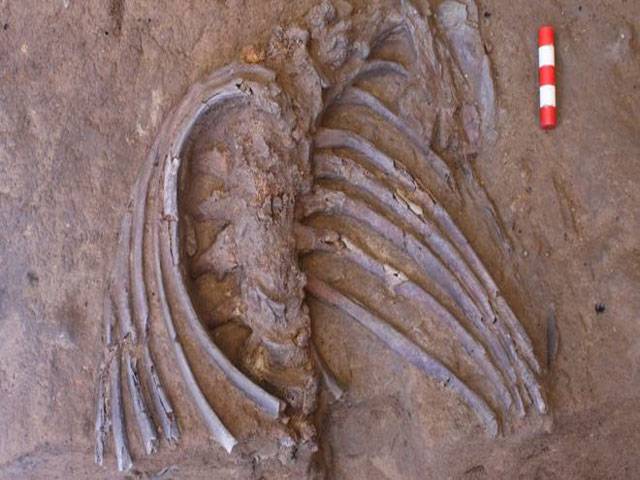LONDON-Researchers have described the first “articulated” remains of a Neanderthal to be discovered in a decade. An articulated skeleton is one where the bones are still arranged in their original positions.
The new specimen was uncovered at Shanidar Cave in Iraq and consists of the upper torso and crushed skull of a middle-aged to older adult.
Excavations at Shanidar in the 1950s and 60s unearthed partial remains of 10 Neanderthal men, women and children.
During these earlier excavations, archaeologists found that some of the burials were clustered together, with clumps of pollen surrounding one of the skeletons.
The researcher who led those original investigations, Ralph Solecki from Columbia University in New York, claimed it was evidence that Neanderthals had buried their dead with flowers.
This “flower burial” captured the imagination of the public and kicked off a decades-long controversy. The floral interpretation suggested our evolutionary relatives were capable of cultural sophistication, challenging the view - prevalent at the time - that Neanderthals were unintelligent and animalistic.
Before the most recent specimen uncovered in Iraq, the last articulated Neanderthal remains were unearthed at Sima de las Palomas in 2006-7 and at Cova Forada in 2010 [Link in Spanish]. Both sites are located in south-east Spain.
But Dr Emma Pomeroy, from the University of Cambridge, said the new skeleton - dubbed Shanidar Z - is more substantial and more completely articulated than those previous finds.
Dr Pomeroy is the lead author of a paper in Antiquity journal describing the find and was part of the excavation team working at the cave in Iraqi Kurdistan.
“So much research on how Neanderthals treated their dead has to involve returning to finds from 60 or even a hundred years ago, when archaeological techniques were more limited, and that only ever gets you so far,” said Dr Pomeroy.
“To have primary evidence of such quality from this famous Neanderthal site will allow us to use modern technologies to explore everything from ancient DNA to long-held questions about Neanderthal ways of death, and whether they were similar to our own.”
Ralph Solecki died last year aged 101, having never managed to conduct further excavations at his most famous site, despite several attempts.
In 2011, the Kurdish Regional Government approached Prof Graeme Barker from Cambridge’s McDonald Institute of Archaeology about revisiting Shanidar Cave.
With Solecki’s support, initial digging began in 2014, but had to be stopped after two days when Islamic State got too close. It resumed the following year.
“We thought with luck we’d be able to find the locations where they had found Neanderthals in the 1950s, to see if we could date the surrounding sediments,” said Prof Barker. “We didn’t expect to find any Neanderthal bones.”
Sunday, November 24, 2024
Neanderthal ‘skeleton’ is first found in a decade

9:58 AM | November 20, 2024
10:58 AM | November 15, 2024
Netherlands beat Germany to reach Davis Cup final for the first time
November 24, 2024
Pakistan and Sri Lanka start strong in T20 Blind Cricket World Cup
November 24, 2024
Diamond Paints clinch 10th Battle Axe Polo Cup 2024 title
November 24, 2024
Guo and De Silva crowned ITF Pakistan Junior Tennis champions
November 24, 2024
Noor Zaman claims CAS-Serena Int’l Squash C’ship title
November 24, 2024
-
Digital nomadism redefines work and travel across the globe
-
Digital nomadism redefines work and travel across the globe
-
Lahore tops global pollution rankings as smog worsens, AQI reaches hazardous levels
-
Hunger crisis to increase in South Sudan, warns UN
-
Pakistan’s judiciary champions climate justice at COP29 in Baku
-
Punjab struggles with persistent smog as Met Office forecast rainfall
Paper Justice
November 23, 2024
No Silver Bullet
November 23, 2024
Reckless Accusations
November 23, 2024
UN Crossroads
November 22, 2024
Smog Trade-off
November 22, 2024
The World: No Longer Livable
November 23, 2024
Unveiling Protein Secrets with AI
November 23, 2024
Outdated Policy
November 23, 2024
Brain Drain
November 23, 2024
Proposal to counter increasing cases of harassment
November 22, 2024
ePaper - Nawaiwaqt
Nawaiwaqt Group | Copyright © 2024





